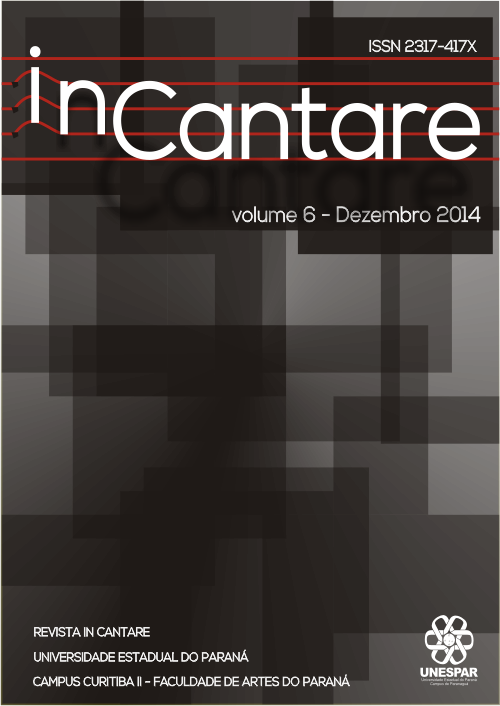Partimento as improvisation pedagogy: renewing a lost art
DOI:
https://doi.org/10.33871/2317417X.2014.5.2.358Palabras clave:
Partimento, Musical Pedagogy, ImprovisationResumen
Throughout the 18thcentury, the practice of partimento flourished in Italian conservatories, spreading eventually to Paris where it functioned as a key pedagogical tool of the "Italian school." Partimenti can be understood to be instructional bass lines, and was used by thousands of classical composers and improvisers across Europe, a fact that is often overlooked. As a music educator who studies improvisation pedagogy, the obsolescence of the practice in the modern pedagogical landscape seems lamentable.Based on my own belief in the potential of this lost tradition to inspire new creative means to musical fluency, the present paper seeks to answer some important questions: What are partimenti?Why do we know so very little of them? How does the practice fit into improvisation pedagogy more broadly? Can a practice of partimento become a part of musical pedagogy in the 21stcentury?
Descargas
Citas
Abramson, R. M. (1980). Dalcroze-based improvisation. Music Educators Journal, 66(5), 62–68.
Bailey, D. (1992). Improvisation: its nature and practice in music. Da Capo Press. USA.
Berkowitz, A. (2010). The Improvising Mind. Oxford University Press.
Brinner, B. E. (1995). Knowing music, making music: Javanese gamelan and the theory of musical competence and interaction. University of Chicago Press.
Christensen, T. S., Gjerdingen, R., Sanguinetti, G., Lutz, R., Snyers, K., &Moelants, D. (2010). Partimento and Continuo Playing in Theory and in Practice (Vol. 9). Leuven University Press.
D., T. (1962). Book Review: Improvisation in Nine Centuries of Western Music by E. T. Ferand. Music & Letters, 43(2), 174–176.
Dobbins, B. (1980). Improvisation: An Essential Element of Musical Proficiency. Music Educators Journal, 66(5), 36.
Elliott, D. J. (1995). Music Matters: A New Philosophy of Music Education. Oxford University Press.
Ferand, E. (1961). Improvisation in nine centuries of western music: An anthology with a historical introduction. Köln,: A. Volk Verlag.
Gjerdingen, R. (1999). An experimental music theory. Rethinking music, 2, 161.
Gjerdingen, R. O. (2007). Partimento, Que Me Veux-Tu? Journal of Music Theory, 51(1), Gjerdingen, R. (2007a). Music in the galant style. New York: Oxford University Press.
Gjerdingen, R. (Ed.). (n.d.).Monuments of Partimenti. Retrieved from http://faculty-web.at.northwestern.edu/music/gjerdingen/partimenti/index.htm
Guderian, L. V. (2008). Effects of Applied Music Composition and Improvisation Assignments on Sight-reading Ability, Learning in Music Theory and Quality in Soprano Recorder Playing. ProQuest.
Hickey, M. (2009). Can improvisation be `taught"™? A call for free improvisation in our schools. International Journal of Music Education, 27(4), 285–299.
Johnson-Laird, P. N. (2002). How jazz musicians improvise. Music Perception, 19(3), 415–442.
Kanellopoulos, P. A. (2011). Freedom and Responsibility: The Aesthetics of Free Musical Improvisation and Its Educational Implications-A View from Bakhtin. Philosophy of Music Education Review, 19(2), 113–135.
Lewis, G. (2000). Teaching improvised music: An ethnographic memoir. In J. Zorn (Ed.), Arcana: Musicianson music (pp. 78–109). New York: Granary Books.
Nettl, B., & Russell, M. (Eds.). (1998). Introduction. In the course of performance: Studies in the world of musical improvisation. Chicago: University of Chicago Press.
PRESSING, J. Improvisation: methods and models. John A. Sloboda (Hg.): Generative processes in music, Oxford, 129–178, 1988.
SANGUINETTI, G. The Art of Partimento: History, Theory, and Practice. Oxford University Press, 2012.
SANGUINETTI, G. (n.d.). The Art of Partimento – Companion website. Retrieved November 2, 2014. Retrieved from http://www.oup.com/us/companion.websites.
SCHUBERT, P. Modal Counterpoint: Renaissance Style (2 edition.). New York: Oxford University Press, 2007.
SILBERMAN, P. Post-Tonal Improvisation in the Aural Skills Classroom. The Online Journal of theSociety for Music Theory, 9(2), 2003.
SLOBODA, J. A. Generative processes in music. Clarendon Press, 2000.
Recebido em: 25 de setembro de 2014
Aprovado em: 03 de dezembro de 2014
Descargas
Publicado
Cómo citar
Número
Sección
Licencia
Derechos de autor 2015 Stephanie Khoury

Esta obra está bajo una licencia internacional Creative Commons Atribución 4.0.
A Revista InCantare adota acesso aberto e o copyright dos artigos e da entrevista pertence aos respectivos autores/entrevistados com cessão de direitos para a Revista InCantare no que diz respeito à inclusão do material publicado (revisado por pares/postprint) em sistemas/ferramentas de indexação, agregadores ou curadores de conteúdo.
Os artigos publicados por esta Revista são de livre uso para compartilhar. É preciso dar o crédito apropriado, prover um link para a licença e indicar se mudanças foram realizadas.
A Revista InCantare não cobra qualquer tipo de taxa para submissão e/ou publicação de artigos.










